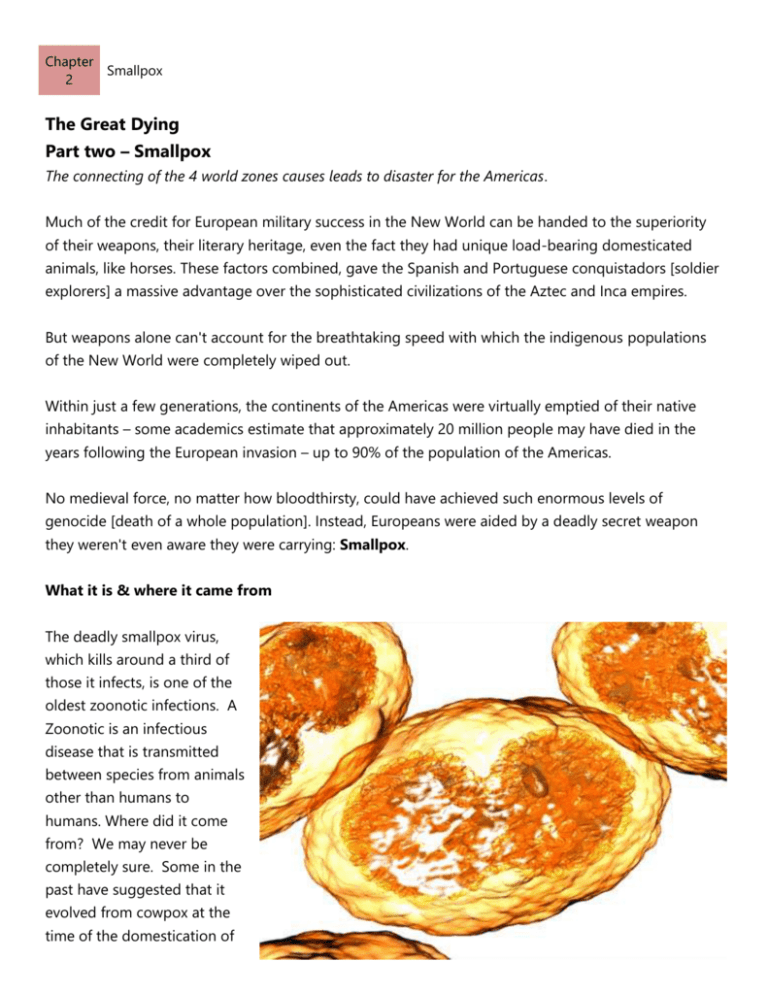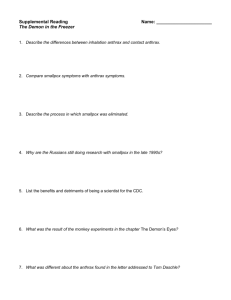Smallpox - Issaquah Connect
advertisement

Chapter Smallpox 2 The Great Dying Part two – Smallpox The connecting of the 4 world zones causes leads to disaster for the Americas. Much of the credit for European military success in the New World can be handed to the superiority of their weapons, their literary heritage, even the fact they had unique load-bearing domesticated animals, like horses. These factors combined, gave the Spanish and Portuguese conquistadors [soldier explorers] a massive advantage over the sophisticated civilizations of the Aztec and Inca empires. But weapons alone can't account for the breathtaking speed with which the indigenous populations of the New World were completely wiped out. Within just a few generations, the continents of the Americas were virtually emptied of their native inhabitants – some academics estimate that approximately 20 million people may have died in the years following the European invasion – up to 90% of the population of the Americas. No medieval force, no matter how bloodthirsty, could have achieved such enormous levels of genocide [death of a whole population]. Instead, Europeans were aided by a deadly secret weapon they weren't even aware they were carrying: Smallpox. What it is & where it came from The deadly smallpox virus, which kills around a third of those it infects, is one of the oldest zoonotic infections. A Zoonotic is an infectious disease that is transmitted between species from animals other than humans to humans. Where did it come from? We may never be completely sure. Some in the past have suggested that it evolved from cowpox at the time of the domestication of Chapter Smallpox 2 cattle. However, recent molecular analysis shows that smallpox’s closest relatives are the viruses that cause camelpox and gerbilpox, suggesting that all three developed quite recently from a common ancestor virus. Smallpox spreads through the air, is inhaled by its victims, and once inside it multiplies in the lymph glands. From there it accesses the bloodstream and targets all the major organs. Here it spends 2 weeks multiplying until the first outward signs of the illness appear. Sore throat, headache, fever and general aches and pains are the first symptoms. However, it is not until the fourth day that the characteristic rash appears and diagnosis can be confirmed. The disease can cause deadly hemorrhaging, where the bleeding causes the pox to turn black, or it can take on a more common form with the pox progressing from red spots, to then filling with fluid and turning yellow as pus accumulates. On the 8th day the sores start to rupture, discharging their virus-filled contents, and then drying into scabs. These scabs eventually fall off, often leaving unsightly scars. During the long course of the illness the sufferers generally remain alert but in excruciating pain from the pox but also from damaged internal organs and throat ulcers. The virus can survive for a long time, and since both the pus and scabs can contain thousands of viruses, these can luck in the dust or be carried away in clothing or blankets. Conditions necessary to strike Smallpox can only become a purely human virus once populations were large enough and dense enough to sustain it, and among the earliest civilizations likely to provide these conditions were those based on irrigation farming in the river valleys of the Euphrates, Tigris, Nile, Ganges and Indus. Camels and gerbils were both common in these regions, so perhaps an ancient pox virus of rodents jumped to humans and camels some 5-10,000 years ago. Chapter Smallpox 2 Europe was first too sparsely populated to maintain smallpox permanently, so it was not until the rise of the Greek Empire that smallpox could extend north into Europe. There was a significant plague in Athens about 1600 years ago, and that could have been the debut of smallpox in Europe. From that point on smallpox seems to have circulated continuously, particularly in the most population dense areas of France and Italy. With each epidemic eruption, some people survived, acquiring antibodies and immunities which they passed on to the next generation. Over time, the population of Europe gained increased immunity, and the devastating impact of traditional infections decreased. Yet the people of the New World had no history of prior exposure to these germs. They farmed only one large mammal – the llama – and even this was geographically isolated. The llama was never kept indoors, it wasn't milked and only occasionally eaten – so the people of the New World were not troubled by cross-species viral infection. When the Europeans arrived, carrying germs which thrived in dense, semi-urban populations, the indigenous people of the Americas were effectively doomed. They had never experienced smallpox, measles or flu before, and the viruses tore through the continent, killing an estimated 90% of Native Americans. How do we know about it? Until recently, historians trusted the written descriptions of disease outbreaks and often ignored archeological records or considered them “secondary” records. Therefore, historians in the past often assumed that the population loss from disease started at the same time as the diseases were first widely reported. Historians reasoned that diseases are not preserved in the soil and only rarely leave traces on skeletons. However, the archeological record is not absent. Archeologists can do things like count the size or number of houses or towns before, during and after the 1500s. Such an approach tells a historian generally whether populations increased or decreased during that time period. For example, in communities in Northern Mexico and what is now current day US (all the way to Mississippi) historians can see a decrease in 80% of population in only 50 years after first contact. In what is now current day Louisiana there was a population loss of 91%. Chapter Smallpox 2 Because the timing of population decline in Mexico (and other areas of the Americas) is consistent and rapid, the spread of European diseases is the only reasonable explanation. No other thing could have had such an effect. We may never know which exact contact was the source of the disease; we may never know how many disease outbreaks occurred after the Europeans arrived, but we do know that Native populations were dying of infectious diseases before anyone began keeping accurate records. Smallpox in the Age of Exploration – The Aztecs The first epidemic of smallpox hit Tenochtitlan in 1520, wiping out more people than the fighting between the Aztecs and the Spanish had. Cortez conducted a ninetythree day siege of the city, blockading it and leaving it without food or water until it surrendered, with only 1/5th of its people alive. It has been argued that without the smallpox epidemic in Mexico, Cortés may not have succeeded against the Aztecs. Historians Ian and Jenifer Glynn, in The Life and Death of Smallpox, claim that “Without the help of smallpox, even horses and guns could not have enabled Cortez, with his army of fewer than 900 men, to defeat the Aztecs and conquer Mexico”. Smallpox claimed an estimated one third of the Aztec population. The Aztec Emperor Cuitláhuac died from smallpox, further throwing the Aztecs into disarray. The Aztec Empire collapsed and Cortés took control of Mexico. The population of Mexico, estimated at 15 to 30 million at the time, shrank to just 3 million by 1568 and approximately 1.6 million by 1620, according to Ian and Jenifer Glynn. Smallpox, they state, “was the principal culprit”. It took only 10 years for the Spanish to gain control of the whole of what we now call Mexico, which they called “New Spain”. A year after the fall of Tenochtitlan, Cortez became Captain General and Chapter Smallpox 2 Governor of New Spain and master of a huge estate, with thousands of Aztecs spared by smallpox and fighting forced to cultivate his land. He enjoyed this life for 25 years until his death in 1547. By the mid-1550s, 130 Spanish families in Mexico controlled 180,000 natives using a system of forced labor (which was actually against the wishes of the king of Spain at the time, Charles V). This change in culture changed the landscape forever. Forests were cut for firewood and for building Mexico City on the ruins of Tenochtitlan. Plows with blades of iron cut deeper than Aztec planting sticks and caused massive soil erosion. Imported cattle, pigs and sheep stripped the native vegetation. The Aztec canal system, one of the most sophisticated in the history of the world, was abandoned. In just a few generations much of the basin of Mexico became useless for large-scale agriculture, so food actually had to be imported. Spanish rule continued, mostly unchanged, for nearly 300 years, until Mexicans were able to gain independence in 1821. Smallpox in the Age of Exploration – The Inca Francisco Pizarro first arrived in the Inca realm in the mid-1520s. By the time he returned in 1532, intent on conquering the Inca Empire, the smallpox epidemic had contributed to the outbreak of civil war in the Empire and caused the death of the Inca Emperor Huayna Capac. His successor, Atahualpa, found himself leader of an Empire weakened and terrorized by a strange and deadly disease. Pizarro, like Cortés, would make the most of the situation. The native Inca warriors already feared the Spanish Conquistadors as gods. Their horses and guns, their white skin and shining armor, both were compounded by the fearful disease which they brought with them and to which they seemed invulnerable. The death of Huayna Cupac, left the Inca empire in civil unrest and war. Smallpox (and other diseases like measles, the flue and typhoid) decimated the Incan population, paving the way for Pizarro's paltry troops to conquer a once-vast nation. "So complete was the chaos that Francisco Pizarro was Chapter Smallpox 2 able to seize an empire the size of Spain and Italy combined with a force of 168 men," writes Charles Mann in "1491" According to Ian and Jenifer Glynn, thirty years after the outbreak of smallpox in Peru “the Inca population had been reduced at least by a half, and possibly by three-quarters”. Historian Donald R. Hopkins concurs with their assessment of the impact of smallpox upon the fall of the Incas. He highlights three principal factors which allowed the Spanish to overcome such overwhelming odds: “It was made possible by a lucky coincidence of Spanish valor and weaponry, Indian superstition, and smallpox”. Summary & Impact Of all the advantages that accrued to the Spanish and Portuguese, the one that many historians believe made the most difference was their relative immunity to the human diseases that came from animals: measles, smallpox, influenza, diphtheria, and the bubonic plague. Native Americans, with no exposure to domestic animals, had never before encountered these micro-organisms and succumbed in overwhelming numbers without even being able to fight. The smallpox epidemic during the Columbian Exchange proved one of the two worst population disasters in recorded history; the other was the plague pandemic in the 1300s. At least half and perhaps as much as 90% of the Amerindian population was lost between 1492 and 1650 to repeated epidemics. The Indians encountered by the Europeans were often the traumatized survivors of extremely advanced civilizations collapsing suddenly from overwhelming disease. Increased colonial movements over land and along the Latin American coast helped to spread the disease even further. The Portuguese colonization of Brazil led to outbreaks throughout the eastern half of South America. Sea links with Buenos Aires spread smallpox to the southern realms of the continent, and Spanish soldiers took the disease to Chile. Major epidemics were to break out all across Latin America for the next one hundred years. While actual figures are variable, more than 20% of the population of the New World are believed to have died as a result of smallpox, with some claiming as much as 80%. Chapter Smallpox 2 In the wake of population loss from European diseases, new cultural patterns evolved. Many remaining native populations settled southward. Some stayed in one location and tried to rebuild their numbers by absorbing smaller remnants into their societies. New groups evolved by fusing together previously separate cultures. Finally, as the Europeans came to the Americas to not just explore but settle, the demand for goods and services increased. In response, some Native Americans took up entrepreneurial roles. Some provided food, and others became river or horse-pack guides. Sources: Big History: From the Big Bang to the Present by Cynthia Stokes Brown Deadly Companions: How Microbes Shaped our History by Dorothy Crawford Death by Disease by Ann Ramenofsky, Archeology Magazine, Vol. 45 No. 2 The History of Smallpox in Latin America by Tony Dunnell





